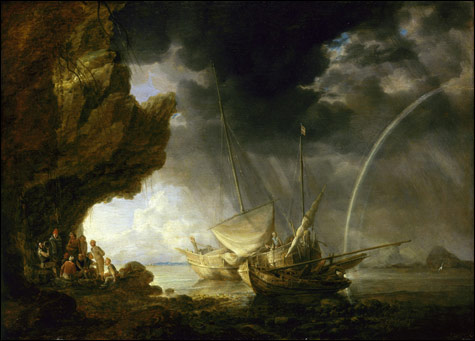The golden age of Dutch sea power sails into Salem
By GREG COOK | June 23, 2009

SEASCAPE WITH SAILORS SHELTERING FROM A RAINSTORM: Is that rainbow a reminder of God’s covenant with Noah? Or is it a show of civic pride in the Dutch colors? |
The Dutch emerged at the dawn of the 17th century as a pre-eminent military and commercial power on the sea. They were in the midst of throwing off Spanish rule and developing a shipping empire that would reach from the Americas to South Africa to Asia. Wealth from fishing and whaling and trade in lumber, sugar, porcelain, silk, spices, and slaves poured into the fledgling republic, financing a "Golden Age" of art, science, and commerce.It was the era of Rembrandt, Frans Hals, and Jan Vermeer. The maps of the Netherlands and Europe lurking in the background of several of Vermeer's paintings suggest the political turmoil, the redrawing of boundaries, that was the backdrop for the calm oases of his domestic interiors. In the Peabody Essex Museum's "The Golden Age of Dutch Seascapes" — which was organized by the National Maritime Museum in England and draws almost exclusively from its collection — seaborne warfare and commerce become the foreground.
Some 70 paintings tell a story of fighting for independence, exploring the world, setting up trading settlements, opening up markets, and shipping home natural resources. It is a composite portrait of the birth of a nation and wealth in the making.
The exhibit, overseen in this iteration by Peabody Essex curator Daniel Finamore, shows the museum doubling down on its seafaring roots with a big tourist-season maritime blockbuster. Those I hear grumbling that PEM doesn't pay enough attention to maritime art any more should be (temporarily?) pleased. The names of the artists will be unfamiliar to most, but it's a vivid and impressively expansive collection of old Dutch seascapes. Perhaps too expansive — after a while, all those boats, rocks, seas, and skies start to fuse. A single canvas of boats on a blustery estuary by Jacob van Ruisdael — often considered the finest Dutch landscape painter of the 17th century because of his near-mystical fascination with space and light — is easy to overlook in the crowd.
The show opens with Cornelis Claesz van Wieringen's circa 1619 painting of Heemskerk's Defeat of the Spaniards at Gibraltar, 25 April 1607. The northern provinces of the Netherlands declared independence from Spain in 1581, and they fought the Spanish on land and sea till 1648, in what became known as the "Eighty Years War." The main complaints were Spain's restrictive rule and its oppression of Protestantism, which was spreading across the Dutch provinces. At the beginning, the Dutch were upstarts taking on a superpower. They were able to outmaneuver the Spanish by fighting on ice skates and breaking sieges by busting dikes to flood the countryside. It helped that Spain was distracted by threats from England and France.
 Related
Related:
Photos: Dutch Seascapes at Peabody Essex, Maritime after time, Art in the air conditioning, More 
- Photos: Dutch Seascapes at Peabody Essex
Dutch Seascapes at Peabody Essex
- Maritime after time
There's no question about the Peabody Essex Museum's unwavering love of all things nautical. How many other museums employ a curator of maritime art and history (in this case, Daniel Finamore)?
- Art in the air conditioning
From Picasso to William "Shrek" Steig's cartoons, and surfer photos to a Twilight Zone toy store, New England offers art worth traveling to this summer. Here we round up the best in the region, no matter the weather or your artistic inclinations.
- Tracking time
The tracks run side by side across cracked, dried mud. But this black-and-white photo by Mark Ruwedel is deceptive.
- An Emperor's heaven on earth
Salem's Peabody Essex Museum has pulled off the curatorial coup of the year with "The Emperor's Private Paradise," which reveals to the public for the first time 90 "treasures from the Forbidden City," the Chinese imperial palace in Beijing.
- After images
Karen Finley won’t be naked, or covered in chocolate. Candied yams will not be involved. If there are neighborhood morality-watch squads in Salem, they’ll have the night off.
- Power plays
Some weeks back, I got to listen to Brown University archæology professor Stephen Houston pronounce the throaty, staccato sounds of Maya hieroglyphs carved across a six-foot-wide limestone panel.
- Slideshow: Treasures from the Forbidden City
The Emperor's Private Paradise at the Peabody Essex Museum, now through January 9, 2011
- Top 10 New England Art Exhibits of 2010
Art – and art spaces — of all sizes
- Painting – and video – of the American landscape
"Painting the American Vision" — 45 rapturous paintings from the New York Historical Society — surveys the Hudson River School painters, dubbed for the upstate New York river where they spent their summers prospecting for sights to transform into ravishing canvases in their Manhattan studios each winter.
- Slideshow: ''Painting the American Vision'' at the Peabody Essex; ''Shifting Terrain: Landscape Video'' at the Currier Museum of Art
This slideshow of images from "Painting the American Vision" at the Peabody Essex Museum and "Shifting Terrain: Landscape Video" at the Currier Museum of Art accompanies Greg Cook's review of both exhibits, "Painting — and video — of the American landscape."
- Less

 Topics
Topics:
Museum And Gallery
, Bonaventura Peeters, National Maritime Museum, Abraham Storck, More  , Bonaventura Peeters, National Maritime Museum, Abraham Storck, Painting, Visual Arts, Peabody Essex Museum, Peabody Essex Museum, Peabody Essex Museum, Jan Vermeer, Daniel Finamore, Less
, Bonaventura Peeters, National Maritime Museum, Abraham Storck, Painting, Visual Arts, Peabody Essex Museum, Peabody Essex Museum, Peabody Essex Museum, Jan Vermeer, Daniel Finamore, Less 